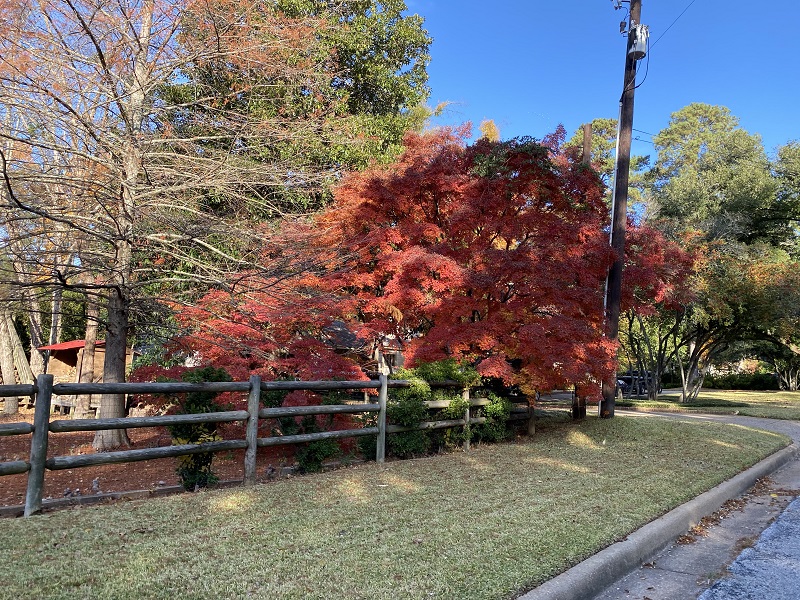The Steps Involved in Garden Design
An Outline of the 5 Steps for a Garden Project: What are the 5 steps of garden design?
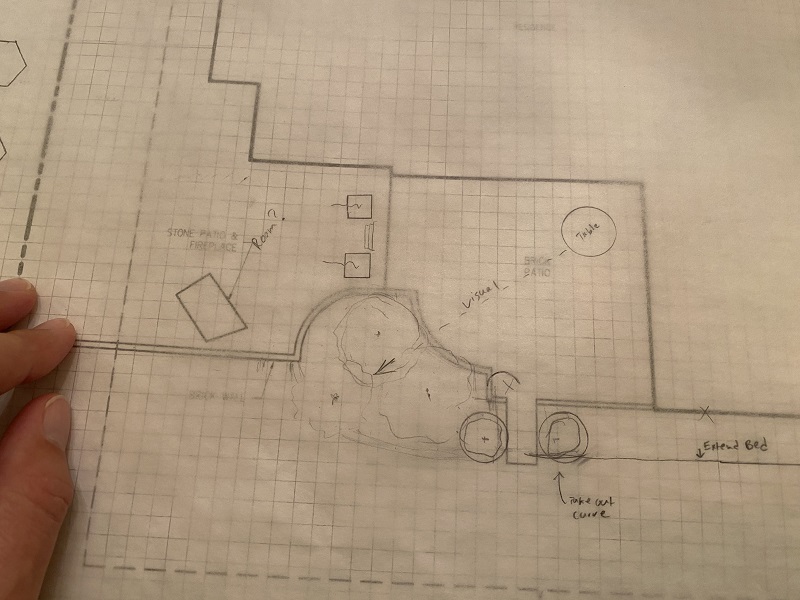
Never mind maneuvers always go at them!
Going straight at a project is more my style, but it is helpful to slow down and ask the question: What are the steps of garden design? I’ll give you a great list from the University of Florida and another list on the principles of garden design from Henry Flowers (former Garden Director at the Round Top Festival Institute and now at Glasco Nursery in Brenham, TX) , but a better subtitle for me would have been an Admiral Lord Nelson Quote “Never mind maneuvers always go at them.” The truth is, we have professionals to help us plan projects and save us money. We have architects for building projects, civil engineers and hydrologists for real estate developments, and we have landscape architects and designers for garden projects. So, to be clear, if you have a project that you need to get right and you need help, seek out a landscape professional who can guide you through this process.
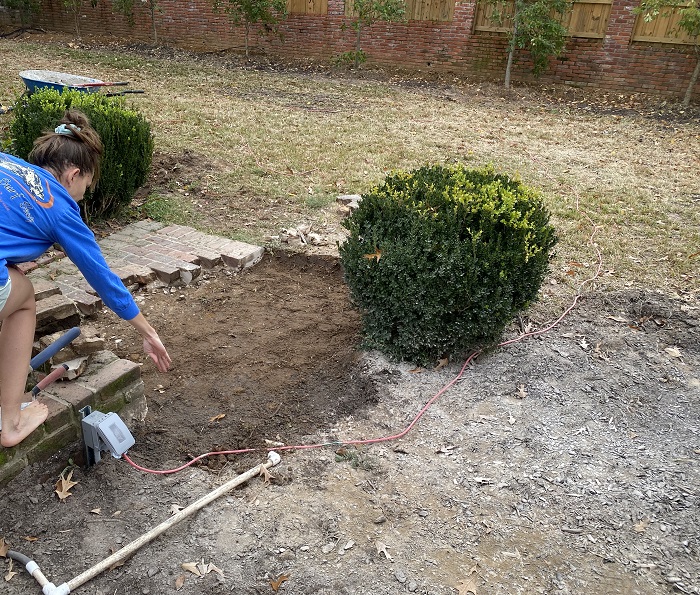
But let’s pretend that you want to try to go at it yourself and you’re ready to forget the maneuvers and put a shovel in the ground. Maybe take a few moments to read below. Even though you might not incorporate all of this, you will use some of this (maybe without even knowing it!) and it will influence you. What are the 5 steps of garden design? Here is a list from the University of Florida:
The five steps of the design process include:
1) conducting a site inventory and analysis
2) determining your needs
3) creating functional diagrams
4) developing conceptual design plans, and
5) drawing a final design plan.
Check out their full article here: https://edis.ifas.ufl.edu/publication/EP375
Now, lest I stray too farm from my alma matter, here are a couple of articles from Texas A&M University on Landscape Design:
- https://aggie-horticulture.tamu.edu/earthkind/planning-the-home-landscape/
- https://aggie-horticulture.tamu.edu/southerngarden/Cottagedesign.html
On the second link from that article, I will use the quote the articles uses from a book co-written by Jim Johnson, who separately taught Rebecca and myself floral design. Remember, before it was “Bulb Hunter” my nickname in the military school at Texas A&M was “Flower”, because Mr. Johnson would very often let us take home large amounts of long cut stem roses on Friday afternoon when there were no more design classes. There I was, walking across the large campus in my WWII uniform with humongous fresh roses flown in from Columbia – fun times. Sorry for the tangent, here is their quote:
“The principles of design are not arbitrary; they are constant. They are the tools of all the arts, and no artist can vary them until he has mastered them. A careful study and understanding of these principles of design enables one to express his personality in art. It is through this mastery that distinction and individuality are created and reflected in design. Distinction is that extra note of quality, taste, and originality for which all persons strive.” – Flowers – Geometric Form by M. “Buddy” Benz and James L. Johnson
That quote was mentioned in this article on designing a cottage garden by Henry Flowers, where he lays out the following 9 principles of design:
- Composition
- Harmony (Unity)
- Focal Point
- Balance
- Proportion
- Line
- Texture
- Rhythm
- Color
Now don’t be too overwhelmed! You don’t have to master the design process to enjoy it and successfully express yourself. We had an interior designer at our house today who very wisely encouraged us to incorporate design features that we prefer and not listen to too many outside voices proclaiming popularity or influence. The big takeaway here, is to work with your preferences, situation, means, etc. and blend with the above outlines and articles or whatever advice you might pick up.
For example, I express myself through bulbs, but you’ll note in Dr. Welch’s article on landscape design that he warns against having so many plants in our garden that we don’t save room for people…well, that applied to me, and I’m learning to express myself in the garden but still leave room for other people…like my spouse’s preferences! Sorry masses of heirloom flower bulbs…I can grow you at the www.southernbulbs.com farming grounds, but you can’t all be in my backyard.

How Long Should I Design?
Where does all of the above fit into the 5 steps of our brick patio garden bed makeover project? It falls under the first point of the following (I wrote last week about the “hidden tasks”):
- The Steps Involved in Garden Design
- The Planned Costs and the Real Costs
- The Hidden Tasks
- The Cleanup and The Remaining Mess
- The Joy of the Process, Hosting During the Makeover, and Living With a Garden Makeover
I’ve given you some great lists and encouraged you to talk to a professional landscape designer. Now, you must be naturally asking, am I taking my own advice? How much of this did I actually do for our project? Some of it, and not in any coherent way. I don’t necessarily think gardening and garden design is as linear as bullet points, processes, and internet algorithms make it out to be. Hopefully this is abundantly clear in these writings. However, I do constantly compare and contrast these amazingly helpful resources. The first step is to just get out there and do it, then do it better, and then do it better again later. Gardening is an iterative process. This is the advice I’m giving now that I actually took.
Honestly, I realized that I had collected all of the information my busy life could collect, so it really came to a point where we had to say “never mind the maneuvers and go straight at it”. How long did it take to get to this point? We’ve lived here for almost 5 years now and we talk about, think about, argue about our landscape at least once a week. Many of the above concepts are floating around in our heads for years and we don’t even think about it.
In fact, the best advice I give any new homeowner for landscape design, is DON’T DO ANYTHING FOR A YEAR. When you move into a house, just live with your new space. Keep the grass mowed and the weeds pulled, but otherwise just observe. What plants, flowers, and perennials will pop up at different times of the year? How does the sun hit various spots of the garden during the different times of the year? Where does water puddle up and not drain well? This gives you time to observe, allows you to not stress and be overwhelmed, and hopefully opens opportunities to communicate with whoever shares the house with you.
Put It On Paper
After living in your space for a long time, I suggest the following (and this was Dr. Bill Welch’s advice to me):
- Have your house and basic garden outline drawn on a 1/8” scale map
- Grab a sheet of sketch paper
- Print off a large version of the 1/8” scale map, tape it to a work table, overlay the sketch paper with masking tape hold it firm
- Grab a good pencil and eraser, and start drawing in plants, sidewalk expansions, etc.
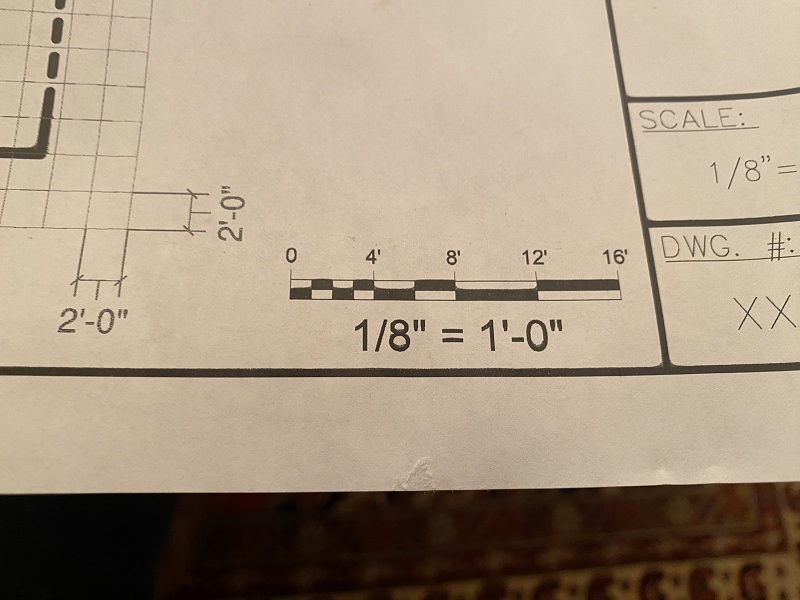
I’ve got to admit, this is like a grown-up version of arts and crafts time, and it’s strangely comforting to work on it little by little like a puzzle. It also helps communicate with other household members. Lastly, it serves as a plan for working with vendors and materials:
- Measure distances for things like irrigation lines
- Calculating plant or other materials like brick and concrete
- Define vistas and views etc.
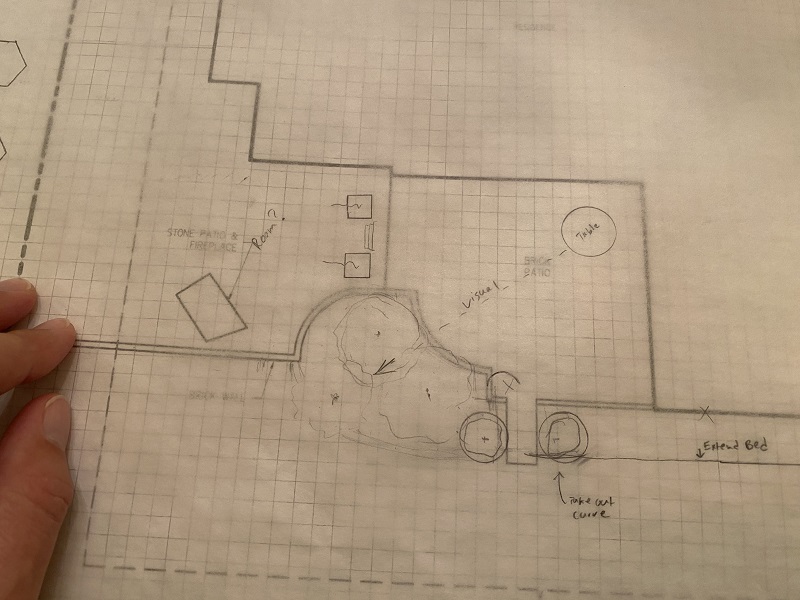
My dad was an accountant and whenever my brother and I had a grand idea for a fishing trip, investment, purchase of any kind, he would say “Well, let’s put it down on paper.” My brother and I interpreted this as code for “this will never happen.” That was not true, but it did slow us down and stop us from starting many bad ideas. It is the same concept here, put it on paper.
Getting Bids Will Save You Money, is Wise, and Will Make you Feel Better
Once your plan starts to formulate, you will begin to get an idea of what vendors need to come out when. This allows a very important step of the process: getting bids. Don’t be afraid to get 2 or 3 bids for every project. For example, we just finished a brick walk expansion today. The first quote was $2,700 (this is 2022 in case you are wondering). The mason was very capable and worth every penny of his quote, but I couldn’t afford to spend $2,700 on this portion of the project. I called another mason who has also done some work for me. His quote was $1,200. One phone call saved me $1,500. Yes, I run the risk of the other person not bothering to give me a quote in the future, but I try to maintain relationships by making my scope of work easy to bid so it doesn’t take too much of their time to shoot me a number.

Getting more than one bid has multiple benefits besides just saving money. It is a wise process to go through. It will slow you down and give you time to process the task. The interaction with vendors will shape your thought on the task. The process of collecting bids is a task unto itself, and forces you to make sure what you want to have done is a priority (if you’re not willing to get multiple bids, is this really a task you need completed?) Last, when you write the check and pay the bill at the end of the process, you know that you are spending your hard-earned money wisely, and you will feel better about the whole process.
Just today, we were saved the heart ache of a project I’ve been agonizing over for awhile. We need power in the middle of our room for a couple of lamps. This room is also brick, and one mason suggested we pull bricks up and lay the line under them and place them back down. The electrician suggested we bore under them from another access point. The mason today looked at the project with me and thought about a way to drill a hole there. Then, the interior designer who visited today said, “You have a plug floor outlet right over here by your rug, just run a thin extension cord under the rug to this point and you’re good.” ($27 on Amazon for a 25’ ultra thin extension chord) So simple. So obvious. I’m so thankful we didn’t start on this project immediately.
Plants for Landscape Design: Hardscape vs. Softscape
Loosely defined, softscape equals plants and hardscape refers to the hard permanent materials that make up the design of your garden. Many people are more comfortable with hardscapes and see them as something that adds more actual value to their real estate, but I will point out, that I’ve seen many a location in an old, abandoned home site filled with flower bulbs, but not a stone remains of the original building…of course any reader here knows my loyalty lies with heirloom flower bulbs that will last generations! All garden moralizing put aside, plant selections can intimidate any home owner.
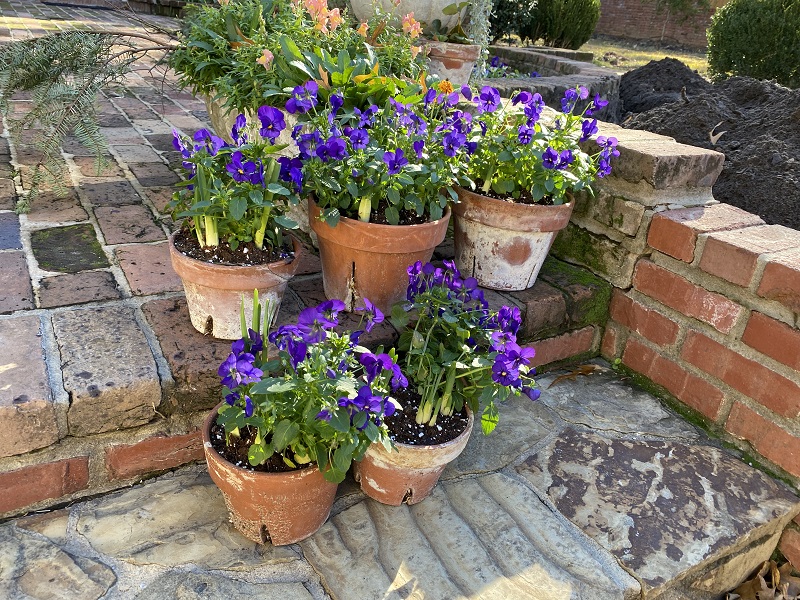
My suggestions for choosing landscape plants? Go to following places to observe what plants might be right for your garden:
- Check out the local garden centers
- Visit local public gardens
- Go for a walk in your neighborhood
- Meetings of local garden clubs or master gardeners
The Shovel Meets the Ground
If you’ve read this far, you’re a trooper. My advice now, is put the shovel in the ground! Literally. Go dig some holes and see what kind of soil you might be dealing with. Plant some annuals. Move some shrubs around. Try fixing some hardscapes yourself and figure out what you can and can’t do and what vendors you might need to hire.
Help, I Want a Professional!
(Non-Disclosure, I’M NOT getting any affiliate money for mentioning these companies.) Sometimes we don’t have time or ability or bandwidth or whatever to do a lot of this ourselves. Hiring a professional is always a great idea! Here in Tyler, TX for example, I would highly recommend anyone with a big garden project to go to Breedlove Nursery and Landscape, Good Works Landscaping, or Landvisions. Apologies now if I forgot anyone and please email me!
Just last week I was on the phone with the president of Calloway’s Nursery with locations in Dallas, Fort Worth, Houston, and now Austin and he was telling me about their new landscape design service. It sounds incredible and you can find out more here.
Last, there has been a plethora of online landscape design companies show up recently. If you’ve tried any of these, I’d love your feedback. Send us an email to info@southernbulbs.com:
- https://tillydesign.com/
- https://homeoutside.com/
- https://www.bacqyard.com/
- https://www.shrubhub.com/
- https://yardzen.com/
Where are you on your current backyard brick patio garden makeover?
Today we had the brick mason scheduled to come out. The irrigation specialist was going to come by, but I expanded the scope of the project and we had to plan for another full day next week. I’m glad they both were not here at the same time. It would have been crowed. My biggest regret, is that the mason, trying to be helpful and clean up, took a pile of dirt I had set aside that was full of Byzantine gladiolus. I fought like crazy to save all the bulbs I could when doing my renovation, and one helpful vendor cleaned up too well today and took my Byzantine glads with him (not all of them). I’m still hurting, but the brick job looks amazing.
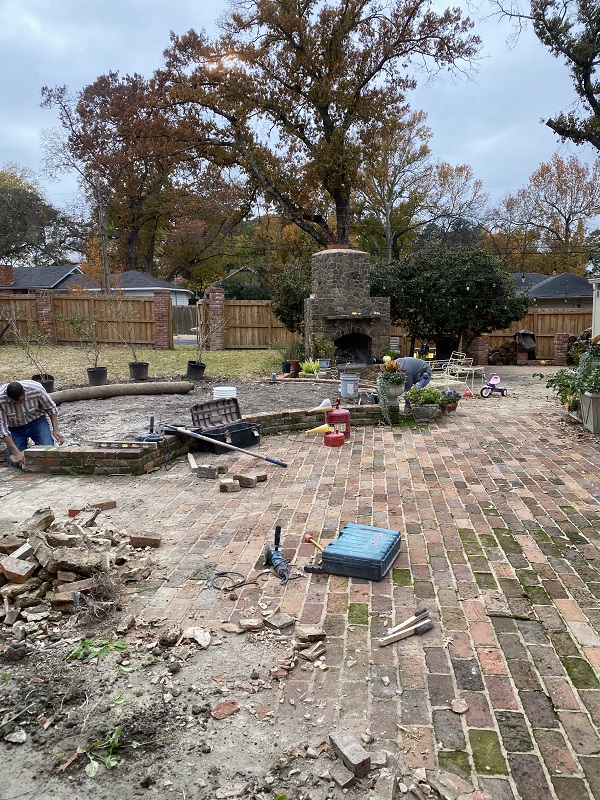
In this part of the project, we took a narrow constriction where our brick patio exited into the backyard and we expanded it to just over 4’ wide. Four feet for us is the minimum width we want for our sidewalks and high flow traffic areas. They started and finished in a day.
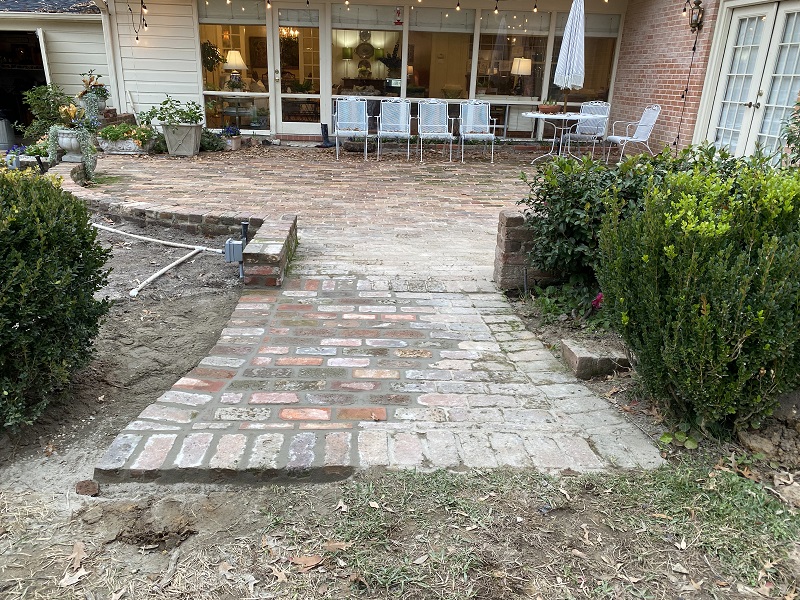
Next Week, What’s Happening Now, and What is Blooming?
Hopefully most of my final cost can be calculated and we can share those next week.
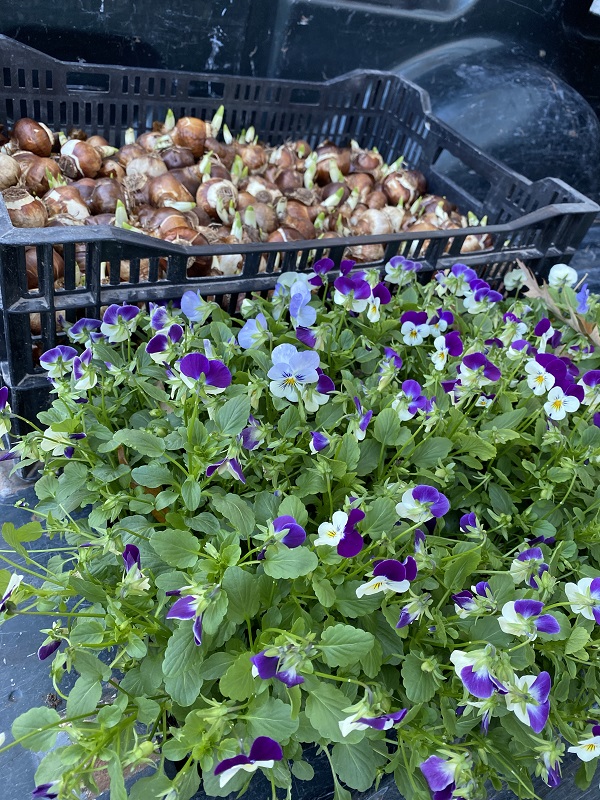
Currently at the Southern Bulb Company (this is week 48 of the gardening year, so December), we are continuing to make more and more paperwhites pots with violas.

In many gardens, camelias are starting to bloom in the old gardens. Camelias with paperwhites are brightening up our December!

Last, fall color is still in full swing in East Texas. This color is from a maple in our neighborhood.
